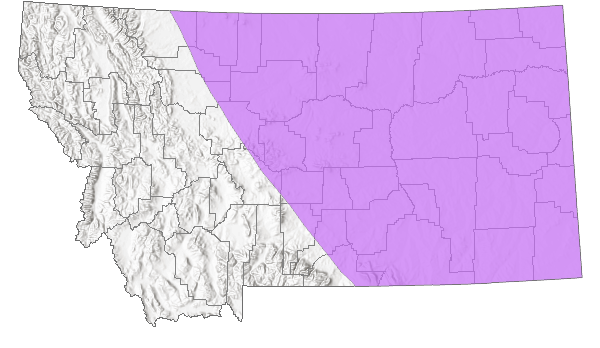View in other NatureServe Network Field Guides
NatureServe
Montana
Utah
Wyoming
Idaho
Wisconsin
British Columbia
South Carolina
Yukon
California
New York
Yellowish Spur-throat Grasshopper - Melanoplus flavidus
General Description
The following is from Brooks (1958), Helfer (1971), Vickery and Kevan (1985), Capinera and Sechrist (1982), Brust et al. (2008), and Scott (2010). General body color is olive, yellowish to red brown. Wings (tegmina) are long, extending to or beyond the abdomen tip and uniform in color with no speckling. Outer face of hind femur is yellow with two upper dark bands, and reddish below. Inner hind femur yellow to orange yellow. Hind tibia is blue or purple. In some texts, this species is also called “Blue-legged Grasshopper.”
Phenology
Overwinters in the egg stage. Eggs hatch in early June. Adults appear in mid to late June and are present to mid-September (Capinera and Sechrist 1982).
Diagnostic Characteristics
Medium sized grasshopper. The body length to end of forewings is 20 to 26 mm for males, and females 25 to 32 mm. For identification certainty, examine the male genitalia and aedeagus, which has a cupped-shaped depression at the tip (Brooks 1958, Helfer 1971, Vickery and Kevan 1985, Capinera and Sechrist 1982, Brust et al. 2008, and Scott 2010).
Very similar to, and difficult to distinguish from the
Sagebrush Grasshopper (
M. bowditchi). Best way to separate the two species is to examine their aedeagus or by habitat (Brooks 1958, Capinera and Sechrist 1982, Brust et al. 2008).
Species Range
Montana Range
Range Descriptions

 Native
Native
Range Comments
Occurs from Michigan, westward to Manitoba and Alberta, Canada; and southward to Arizona and Texas (Capinera and Sechrist 1982, and Vickery and Kevan 1985). In Montana, it has been reported in four counties.
Habitat
Prefers sparsely vegetated grassy areas in sandy soils, blowout areas and yucca clumps (Capinera and Sechrist 1982, and Brust et al. 2008).
Food Habits
Considered forbivorous, preferring sunflowers and
western ragweed (
Ambrosia psilostachya), as well as
lead plant (
Amorpha canescens),
white sagebrush (
Artemisia ludoviciana) and goldenrod. It resorts to grasses only when forbs are in short supply. At such times, it may start feeding on
alfalfa (
Medicago sativa), cabbage, plum, and cherry leaves (Capinera and Sechrist 1982, and Brust et al. 2008).
Reproductive Characteristics
After hatching, this species passes through 5 nymphal instars. Egg pods contain 14 eggs arranged in two or three disorderly columns (Capinera and Sechrist 1982).
Stewardship Responsibility
References
- Literature Cited AboveLegend:
 View Online Publication
View Online Publication Brooks, A.R. 1958. Acridoidea of Southern Alberta, Saskatchewan, and Manitoba (Orthoptera). The Canadian Entomologist (Supplement 9) 90:5-92.
Brooks, A.R. 1958. Acridoidea of Southern Alberta, Saskatchewan, and Manitoba (Orthoptera). The Canadian Entomologist (Supplement 9) 90:5-92. Brust, M.L, W.W. Hoback, and R.J. Wright. 2008. The Grasshoppers of Nebraska. Lincoln, NB: University of Nebraska Extension Service, APHIS.
Brust, M.L, W.W. Hoback, and R.J. Wright. 2008. The Grasshoppers of Nebraska. Lincoln, NB: University of Nebraska Extension Service, APHIS. Brust, M.L., W.W. Hoback, and R.J. Wright. 2008. A Synopsis of Nebraska Grasshopper Distributions. Journal of the Kansas Entomological Society 81(3):208-255.
Brust, M.L., W.W. Hoback, and R.J. Wright. 2008. A Synopsis of Nebraska Grasshopper Distributions. Journal of the Kansas Entomological Society 81(3):208-255. Capinera, J.L. and T.S. Sechrist. 1982. Grasshoppers of Colorado: Identification, Biology, and Management. Fort Collins, CO: Colorado State University Experiment Station, Bulletin 584S. 161 p.
Capinera, J.L. and T.S. Sechrist. 1982. Grasshoppers of Colorado: Identification, Biology, and Management. Fort Collins, CO: Colorado State University Experiment Station, Bulletin 584S. 161 p. Helfer, J.R. 1971. How to Know the Grasshoppers, Crickets, Cockroaches, and Their Allies. Revised edition (out of print), Mineola, NY: Dover Publications.
Helfer, J.R. 1971. How to Know the Grasshoppers, Crickets, Cockroaches, and Their Allies. Revised edition (out of print), Mineola, NY: Dover Publications. Scott, R.D. 2010. Montana Grasshoppers, Katydids, and Crickets A Pictorial Field Guide to the Orthoptera. MagpieMTGraphics, Billings, MT.
Scott, R.D. 2010. Montana Grasshoppers, Katydids, and Crickets A Pictorial Field Guide to the Orthoptera. MagpieMTGraphics, Billings, MT. Vickery, V. R. and D. K. M. Kevan. 1985. The grasshopper, crickets, and related insects of Canada and adjacent regions. Biosystematics Research Institute, Ottawa, Ontario. Publication Number 1777. 918 pp.
Vickery, V. R. and D. K. M. Kevan. 1985. The grasshopper, crickets, and related insects of Canada and adjacent regions. Biosystematics Research Institute, Ottawa, Ontario. Publication Number 1777. 918 pp.
- Additional ReferencesLegend:
 View Online Publication
View Online Publication
Do you know of a citation we're missing? Bland, R.G. 2003. The Orthoptera of Michigan—Biology, Keys, and Descriptions of Grasshoppers, Katydids, and Crickets. East Lansing, MI: Michigan State University Extension, Bulletin E-2815. 221 p.
Bland, R.G. 2003. The Orthoptera of Michigan—Biology, Keys, and Descriptions of Grasshoppers, Katydids, and Crickets. East Lansing, MI: Michigan State University Extension, Bulletin E-2815. 221 p. Capinera, J.L., R.D. Scott, and T.J. Walker. 2004. Field Guide to Grasshoppers, Katydids, and Crickets of the United States. Ithaca, NY. Cornell University Press.
Capinera, J.L., R.D. Scott, and T.J. Walker. 2004. Field Guide to Grasshoppers, Katydids, and Crickets of the United States. Ithaca, NY. Cornell University Press. Kirk, K. and C.R. Bomar. 2005. Guide to the grasshoppers of Wisconsin. Madison, WI: Wisconsin Department of Natural Resources, Bureau of Integrated Science Services PUB-SS-1008. 154 p.
Kirk, K. and C.R. Bomar. 2005. Guide to the grasshoppers of Wisconsin. Madison, WI: Wisconsin Department of Natural Resources, Bureau of Integrated Science Services PUB-SS-1008. 154 p.
- Web Search Engines for Articles on "Yellowish Spur-throat Grasshopper"
- Additional Sources of Information Related to "Insects"





